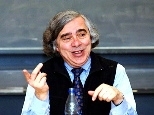Technology Review chief correspondent David Talbot recently interviewed Energy Research Council co-chair Ernest J. Moniz about the council's thinking and its recommendations. The following is an excerpt of that interview. For full text, visit Technology Review's web site.
Q. Headlines these days are full of talk about $3-a-gallon gas. What are the fundamental energy issues facing the world today?
A. As we cast it in our report, there are three major drivers. The first is simply the supply and demand equation, particularly driven by developing and emerging economies. One sees in most projections a doubling of energy use by mid-century, and a tripling of electricity use by mid-century. This is a staggering problem or challenge, particularly when you realize that today, 86 percent of primary energy comes from fossil fuels, and conventional oil production may be peaking.
The second driver is security: the security of oil supply, and also nuclear proliferation. And third is environmental, especially climate change. If society gets serious about controlling greenhouse-gas emissions, this would be the most profound challenge to the structure of our energy supply, because that supply is based on fossil fuel. Controlling carbon dioxide, while also doubling energy use, is a rather remarkable challenge to contemplate.
Q. What is the timetable for the R&D and deployment to get the job done?
A. It's useful to think in terms of a 50-year timetable. For doing something about climate change, these next 50 years are critical. Fifty years is also the characteristic time for major changes of the energy supply system, if you look at the transition from wood to coal -- then oil coming in, then gas coming in.
Well, if we have a challenge we need to meet in 50 years, and it takes 50 years to turn over the energy system, that defines a challenge that you must begin to meet today. The energy challenge is -- if not the primary area -- certainly one of the primary areas for the application of science, engineering and policy to meet real human needs.
Q. What are the Energy Research Council's recommendations for how MIT conducts research and educates students?
A. Hopefully we can contribute much more strongly to solving these energy challenges. We suggest that we think about the problem along three lines. One is a set of basic science and engineering activities that will hopefully lead to transformational energy technologies down the road. It may be decades until these are fully realized in the energy marketplace. This consists of areas such as solar power, potentially an enormous resource, but faced with many technical and economic challenges. And it would include biofuels, batteries and fuel cells, and so on. These are all areas where we have significant research today at MIT, a good foundation for building up research programs.
The second area is improving today's energy systems. It's very appropriate for a university to be involved in basic research that may take a long time to influence the marketplace. But it is also important to get from here to there. We need to better deploy and use today's energy systems, mainly fossil fuels. We simply must use these resources more efficiently. We also need to advance nuclear power technology so as to address public concerns.
The third area emphasizes the global nature of energy challenges, including those in developing countries. Research includes topics from the science and policy of climate change to building efficiency, transportation systems and urban design. For example, we would bring together our experience with passenger vehicle systems, with our supply-chain expertise to design the world's freight systems of the future.
Q. How do these proposed research efforts differ from what is happening now at MIT?
A. This adds to and supplements what is going on today with multidisciplinary programs, as opposed to individual investigator programs. Energy, inherently, is not just one discipline. We believe MIT has been especially strong in being able to mount these kinds of research efforts and focus on solving hard problems across disciplines. Clearly there are many energy initiatives at many universities, but we believe this is one of the distinguishing features that MIT can bring to the table. We also have an especially strong history of working with industry; many of these initiatives will, by definition, require a close collaboration with industry. And we have a strong history of technology innovation and entrepreneurial spirit. We want to capture that in our energy initiative.
Q. How much funding will these efforts need, and where will the funds come from?
A. Obviously we will need to gather the resources from some combination of donors, industry and government. The costs are notional at the moment, but clearly if you are supporting a multifaculty program, we are talking one to several million dollars per year, for a number of years, for each research focus area. And clearly, different parts of the agenda will be more attractive to different kinds of funders. This will take time to build up, so we suggest a phased-in approach, over a five-year time period.
A version of this article appeared in MIT Tech Talk on May 3, 2006 (download PDF).






